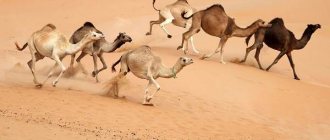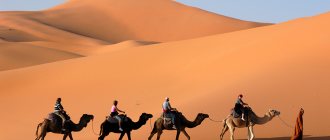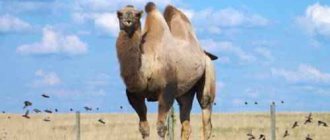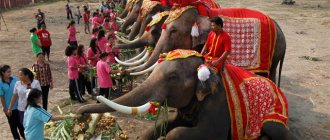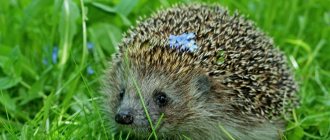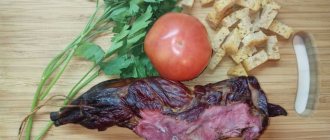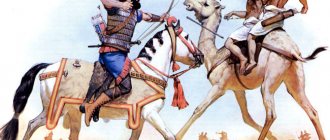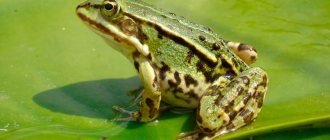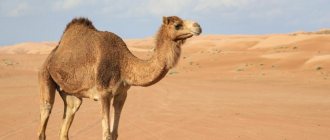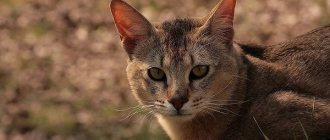The unique organism of this animal still continues to amaze and puzzle scientists. Almost every “detail” of it is designed for survival in conditions of hellish heat, sparse vegetation and water shortages. When in 1974−75. A terrible drought broke out in Somalia, 60% of large and small livestock and only a tenth of camels died.
Photo: Ltshears, wikipedia.orgEven a loaded camel can travel in a caravan for 10 days without ever quenching its thirst. Of course, he shows such restraint only out of necessity. As one camel said in a joke: “No matter what people say about us, we’re still thirsty!” Therefore, as soon as the animal gets to the watering hole, it shows another of its talents - to get drunk quickly and to its fullest. A dehydrated camel can absorb 130-135 liters of liquid in 10 minutes without bursting. In the future, this water will be used in the body extremely economically and cleverly.
Photo: Steve FE-Cameron, wikipedia.orgTo understand where the camel’s superpowers lie, let’s “disassemble” its body piece by piece.
Origin of the species and description
Photo: Bactrian camel
Bactrian or Bactrian camel (Camelus bactrianus) belongs to the camelid genus. Class: mammals. Order: artiodactyls. The main differences between the Bactrian camel and other representatives of this genus are not only the presence of a second hump, but also the thick coat of hair. Bactrian camels are very hardy animals; they can easily survive summer drought, snow and frost in winter.
Video: Bactrian camel
Camels are very ancient animals; the first images of a camel date back to the 19th century BC. The first finds of biological remains of ancient camels date back to 2500 BC. Camels were domesticated in the 6th-7th millennium BC. Camels are one of the first animals that people began to breed and raise for their needs. People used and still use camels primarily as transport. Camel wool, from which clothing can be made, and milk, camel meat, which is excellent for food, are also considered valuable. The main populations of camels used to live in ancient Asia.
The first description of this species was made in 1878 by researcher N. M. Przhevalsky. Unlike one-humped camels, two-humped camels have been preserved in the wild. Today, Bactrian camels are divided into 2 species: Camelus ferus is a wild camel and Camelus bactrianus is a domestic Bactrian. Recently, the population of this species has been rapidly decreasing, and humans are to blame for this.
Usage
— Advertising —
Previously, huge herds of wild dromedary camels roamed the deserts of northern Africa and the Middle East, but now only domesticated individuals are found in Asia and Africa, where they are kept as pets (carriage and riding). Herds of wild dromedary camels have not survived in nature. Only in Australia are secondary feral herds found.
Appearance and features
Photo: Bactrian camel, or Bactrian
The Bactrian camel is a large animal with a strong and massive body. Camelus bactrianus has a large, rounded body. Long and massive legs that end in a cloven foot on a callus pad. A camel's neck is strong and strong, which bends downward and then bends upward. Wild camels of this species have a thick and dense coat of brown-sand color. However, there are also brown and white (cream) camels. True, light-colored camels are quite rare and are more valuable.
The camel's head is small. The camel has unusual mobile and hard lips, which are adapted to tearing rough desert vegetation and prickly cacti. The upper lip of the animal is slightly forked. The ears are round and small. There are paired glands on the back of the head, which are more developed in males. The camel's eyes are protected from sand and dust by long and thick eyelashes.
Bactrian camels are quite large and massive animals. The height of the male at the withers can reach 230-240 cm. The top of the humps is at a height of 170 centimeters; the height of the humps can vary depending on the internal state of the animal, but usually the size of the humps can reach 0.5 meters in height. The distance between the humps is 30 cm. The weight of an adult male is from 750 kg to 1 ton. Female animals of this species are several times smaller than males, ranging from 400 to 750 kg.
The internal structure of the Bactrian camel is the same as that of all calloused camels. The camel has a three-chamber stomach, in which 3 sections are distinguished (rumen, abomasum and mesh). The cecum of camels is short. The kidneys can absorb water from urine. Camel blood can maintain normal fluidity, even when quite thickened, thanks to the special oval shape of red blood cells that can easily pass through capillaries. Also, red blood cells in a camel’s blood are capable of accumulating liquid, increasing in volume several times.
Interesting fact: The Bactrian camel can go without water for up to a week, which is impossible for more than one animal in desert conditions. But when a camel gets access to water, it can drink up to 100 liters at a time.
The humps of camels contain fat, which is a reserve of nutrients. The humps help insulate the animal. If the fat were evenly distributed throughout the camel's body, it would not allow heat to escape from the body. A camel's humps contain up to 150 kg of fat.
The external structure of the animal allows it to save moisture in the body. A camel's nostrils are always closed; they open only when inhaling or exhaling. This also makes it easier to move through the desert, minimizing the entry of dust into the nostrils. Sweat appears on a camel's body when the camel's body temperature reaches 41°C. Camels are long-lived; on average, a wild camel in good living conditions lives on average up to 40-50 years.
Now you know what the Bactrian camel is called. Let's see where he lives.
Where does the Bactrian camel live?
Photo: Bactrian camel in Mongolia
In the past, camels settled over fairly large areas. Bactrian camels could be found in Asia, China, and Mongolia. In the modern world, the population of Bactrian camels has decreased greatly, and the habitat of the animals has become small. Now these animals live in four small isolated areas in China and Mongolia. In Mongolia, camels can be found in the Gobi. In China, camels live near Lake Lop Nor.
Domestic Bactrian camels can also be found in Asia, Mongolia, Kalmykia, and Kazakhstan. Several breeds of domestic camels were bred for household use: the Mongolian Bactrian camel, the Kazakh Bactrian, the Kalmyk Bactrian. Animals of these breeds differ in size, coat quality, shape, and the size of their humps.
In the wild, Bactrian camels are constantly on the move. They must constantly migrate in order to find a source of water and food. The harsh conditions of the harsh climate do not allow animals to relax. In herd habitats, animals are tied to bodies of water. During the rainy season, camels live near the pond. However, in the summer, drought sets in, and when the reservoirs become shallow and vegetation becomes scarce, camels go in search of water and food.
In summer, camels can go far into the mountains and rise to a height of up to 3200 m above sea level. In the winter season, animals go south. They can travel 400-700 km. towards the south, where they settle near the foot of the mountains and in the valleys where they will be protected from cold winds. In winter, the main thing for camels is to find food for themselves; unlike horses, camels cannot dig through the snow to look for food underneath. Therefore, autumn migration is necessary for camels to save their lives.
Interesting fact: During migration, an adult camel is able to cover a distance of 90-100 km!
Spreading
The dromedary is common as a pet in northern Africa and the Middle East up to India. The species has been introduced to the Balkans, southwest Africa and the Canary Islands, as well as Australia. It is in the territory of the latter that between 50,000 and 100,000 individuals live, and today it is the only large population of dromedary camels in the world that lives in the wild.
What do Bactrian camels eat?
Photo: Bactrian camel from the Red Book
Bactrian is a completely harmless herbivore.
The main diet of Bactrians consists of:
- shrubs and subshrubs of the Sálsola (Salyanka) plant;
- camel-thorn;
- ephedra (Éphedra);
- young shoots and leaves of Saxaul (Halóxylon);
- barnyard grass, parnofolia.
The structure of the camel's mouth and lips is designed in such a way that these animals can pick and eat hard and prickly plants with large needles without harm to the body. In autumn, camels can feast on poplar leaves, reeds, and onions. In winter, when there is no vegetation and camels need a source of protein, camels can eat animal skins and bones. Wild camels can easily drink salt water from reservoirs. Domestic camels can be more picky and require clean water to drink. In winter, domestic camels can eat hay, oats, buckwheat grass, porridge made from it, and breadcrumbs. In summer, camels look for hard grass.
Bactrians are loved to be kept in agriculture because they are indiscriminate in food and unpretentious in the conditions of their detention. Camels, like many warm-blooded animals, recover greatly by autumn. They store fat in their humps to make it easier to survive the winter. Camels easily survive long periods of fasting. For these animals, sometimes fasting is even better than overfeeding.
Legs
“The camel was looking for horns, but lost its hooves.” (Proverb)
The already long legs of this animal are unique. It is not without reason that many scientists decided that it had no place among the artiodactyls, and they classified camels (as well as related llamas) into a separate order - callouseds. If only because calloused animals have no hooves - their two-toed limbs are decorated with crooked and very blunt claws. Therefore, when walking, camels do not rely on the tips of their toes, like ungulates, but on all phalanges. And to prevent the camel’s foot from falling into the hot sand and getting burned, its lower surface is protected by an elastic calloused pad.
Photo: Bjorn Christian Torrissen, wikipedia.org; scan from the book “Wild Herds” by D. Neary, M: Mir, 1984.Calluses also protect the camel's knees and chest, in case it decides to lie down to rest.
Features of character and lifestyle
Photo: Bactrian camel
Wild Bactrian camels have an aggressive and passionate character. They are quite smart and careful. Due to their frequent migration, they are patient and able to travel long distances. Pets are calmer, more often even apathetic, timid and stupid. In nature, camels live in small herds of 7-30 heads. The herd has a developed social structure. There is a leader - this is usually a large dominant male; during the rutting period, the leader is the only adult male in the herd; he protects the females and young animals. During standing, other adult males can also join the herd; they must obey the will of the leader.
Due to the fact that the bulk of the herd consists of young animals and females, the majority of the herd lives peacefully. The main battles occur between males, for the right to be the leader, and for the female. Male camels are extremely dangerous during the rut, both for humans and other animals. Quite often, adult males can live and migrate alone. Females always gather in herds to protect their offspring. Camels are active during the day. At night, camels sleep or chew cud. In bad weather, camels take refuge in caves, ravines, and at the foot of the mountains. During a sandstorm or hurricane, a camel can lie motionless for several days.
These animals can easily endure the summer heat and heat; camels walk calmly, while fanning themselves with their tail. During migration they cover long distances. In summer, representatives of this species go in search of lush greenery and water in the mountains, in winter they head towards the south.
Interesting fact: Despite the fact that camels live mainly in the desert, these animals can swim well. They are not afraid of water and can swim across bodies of water.
Sacred animal
Did you know that Arabs affectionately call a camel “jamil”, which means “beautiful”? But this is only the first part of the translation: the last syllable “il” is equated to the word “god”. And without this “beautiful god” not a single religious ritual begins in the East.
The next interesting fact about the camel is related to vocabulary. There are about 6,000 words in Arabic that refer to this sacred animal. There are different names for females and males, old and young camels are called differently, differing in shade of color, breed and intended for transporting goods or people. After all, even a tired camel has its own name. Such diversity can only be explained by the greatest respect for this animal.
Another fact about the camel, interesting from the point of view of education, is that the most popular wish for a boy among the Arabs is considered to be as hard-working and full of dignity as this majestic animal. Girls want to learn the camel's grace and endurance.
Social structure and reproduction
Photo: Bactrian camel calf
Camels, both male and female, reach maturity by 3-5 years. The mating season for camels falls in autumn. At this time, animals feel good, and females have the resources to bear healthy offspring. During the rut, males are especially aggressive. Skirmishes constantly occur between males, and sometimes males may try to mate with other males. The males begin to rush around madly, attack others, and make loud noises.
The leaders of the herd herd the females into one place and do not allow them to disperse. During the rut, males are extremely dangerous. They can attack both humans and other animals. During the rut, both males and females mark their territory with urine; for the same purposes, males also use the occipital glands, touching stones with their heads. During mating games, the female lets the male know that she is ready to mate by lying down in front of him and bending all four legs.
Camels mate while lying down. During mating, males grind their teeth and foam at the mouth. Pregnancy in a female camel lasts 13 months. A baby camel is born weighing from 30 to 45 kilograms. Newborn camel calves immediately stand well on their feet, and almost immediately after birth they can follow their mother. Camel calves have the rudiments of humps, which do not yet contain fat reserves, however, in the second month of life, the humps rise.
The female feeds the cubs up to 1.5 years. Of these, up to 4 months, the baby camel’s diet consists exclusively of mother’s milk, after which the cubs begin to get used to plant foods, grass, and shrubs. A female can give birth several times a year, and there are cases where a female feeds several of her older and younger cubs at the same time. Females protect their offspring, protecting their own and others’ cubs from other animals.
Natural enemies of Bactrian camels
Photo: Bactrian camel in the desert
In the past, the main enemy of camels was the tiger. Tigers lived in the area of Lake Lob Nor, and camels used to live there as well. Tigers are very cunning and dangerous predators; they are not afraid of the fact that a camel is much larger than it. Tigers chase their prey for a long time and attack in situations where the camel is completely unarmed. Most often, young animals and weakened females become victims of predators.
Due to attacks by tigers on domestic herds, people began to hunt and kill tigers near settlements where camels were bred. Today, camels and tigers are not found because tigers have disappeared from the areas where camels live. And wolves became the main dangerous enemies for camels. It should be noted that camels, although cowardly, are stupid animals and are attacked by all predators. Despite the enormous size of the animal, even a raven and other birds of prey can offend it by pecking at unhealed wounds on the animal’s body. In addition to predators, parasites are also dangerous for camels.
The main parasites to which Bacrian is susceptible:
- mites;
- tapeworms and annelids;
- nemitod worms;
- various helminths.
Camels most often die from infection with worm parasites. Among camels, infection with parasitic worms is a very common disease. Infection occurs while eating. Helminth eggs are found on plants that the animal consumes as food, and along with the food, the worms enter the camel’s body.
Camels are also susceptible to diseases such as:
- tetanus;
- tuberculosis.
Mycoses can form from moisture and dampness with reduced immunity. This is a fungal infection of the skin that greatly harms animals. The last enemy of camels, but the most dangerous, is man. Recently, hunting of Bactrian camels has been prohibited, but in the past camels were often killed for the animal's skin, fur, and meat. Because of this, the population of this species has decreased significantly.
Population and species status
Photo: Bactrian camels
Wild Bactrian camels have been considered very rare animals since the beginning of the 20th century. At the moment, the population of Bactrian camels is on the verge of extinction. There are only a few hundred of these animals left in the entire world. According to some sources, about 300, according to other sources, about 900 individuals. The species Camelus bactrianus is listed in the Red Book and has the status of a critically endangered species. Hunting camels has been prohibited for many years, however, poachers still kill the animals. Every year, up to 30 camels are killed by poachers. Most often, poachers waylay animals during migration.
In addition, enormous damage to the population of this species was caused during nuclear tests carried out by China. China's ecology is in a deplorable state, and after these tests, the land and water bodies will be dangerous for many years to come. Nuclear waste pollutes soil and water. And not only camels, but also many other animals die from poisoning and exposure to radiation. Camels were also greatly harmed by the development of gold mining sites and the construction of factories in Mongolia and China.
Interesting fact: An adult camel is so hardy that it can survive even severe dehydration. For an ordinary animal, losing 20% of the water contained in the body is certain death; a camel survives even after losing up to 40% of the fluid.
Camels are leaving their usual habitats because people have come there. Camels are also poisoned by potassium cyanide, which enters the environment during gold processing.
